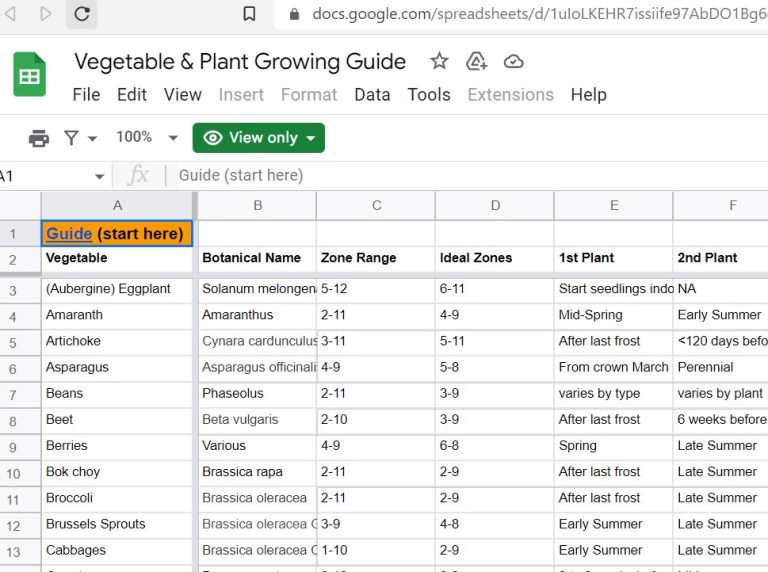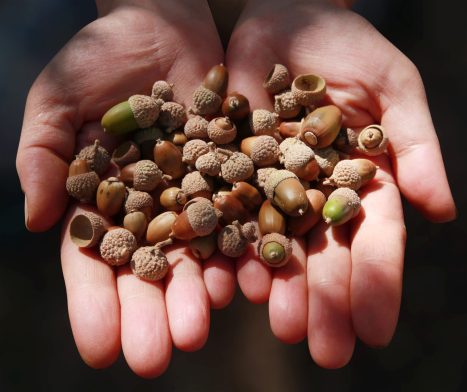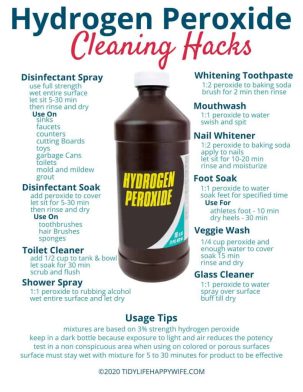In this guide, you will find nearly 1,000 data points for growing 47 different plants ranging from the common to the not-so-common.
This guide is strictly for informational purposes. Different varieties of plants within the same family may have different growing times, nutritional values, harvest yields, and caloric densities. Please research your specific plant to fine-tune your care and cultivation for maximum yields.
You will also find that one plant type may have so many varieties within it that they could each have a spreadsheet of their own. For instance, there are over 400 berries, over 1,000 varieties of potatoes, and 10,000 varieties of tomatoes. Obviously, we can’t capture all the varieties available to you, all their shapes, varying nutritional properties, etc. Still, we strived to provide you with basic information about each plant to start you out on your growing journey. From here, you will want to research more about your specific varieties and adjust soil where needed to maximize yield.
Thanks for downloading the Vegetable & Plant Growing Guide https://docs.google.com/spreadsheets/d/1uIoLKEHR7issiife97AbDO1Bg6dd8dQ53oKPCUj8ehU/edit#gid=0

To work with the sheet and make changes, additions, or subtractions, you will need to first be logged into YouTube or Gmail in your browser, and then on the spreadsheet, click File > Make a Copy and save your own sheet.
EXPLANATION OF COLUMNS
Botanical Name – The most common Latin name for the plant. Specific cultivars will vary. This is for your further research but also to help you understand that Bok Choy, Brussel Spriouts, Cabbages, Cauliflower, Broccoli, Cale Collard Greens, and Turnips are all one happy family. As such, much of their care and maintenance are similar.
Zone Range – Zone range is the far extremes of the temperature zones for the plant. Could you grow plants in zone 1 or 13? Sure. You would have to modify the environment, though. These zonal ranges are for plants outside.
Figuring Out Your Zone
A plant hardiness zone is a geographic area defined mainly by a ten-year average minimum temperature. Some zone calculations also consider other factors. The most commonly used hardiness scale in America is the United States Department of Agriculture scale. It ranges on a scale from 0 to 13. I will link to that one in the description section below so you can determine your zone. In the description section below, I will also link to the equivalent European and other parts of the world’s hardiness scale. As the USDA system is based entirely on an area’s average annual extreme minimum temperature, it is limited in describing the full climatic conditions a gardener may have to account for in a particular place.
Zone Links in the Notes section below.
Ideal Zones – This is the range where the plant typically thrives best and may actually exist in the wild.
1st Plant – This column tells you a little bit about when you can plant after winter. It’s your in-ground time, as you might start seedlings indoors.
2nd Plant – Some plants will allow you to plant a successive planting. This will allow you to harvest twice. Typically, this can only be done in warmer hardiness zones where the growing period is longer. In many cases, a second planting isn’t possible, or the plant is perennial and not completely harvested.
Maturity – This is the minimum date before any harvest can occur. Plants, even within the same species, may vary in their maturity dates. Some plants can be harvested earlier (i.e., zucchini), or some of the leaves may be harvested.
Cal per Cup – Calories per cup of vegetable or fruit. This, too, can vary by plant type.
Yield from 4 Plants – This is the expected harvest from 4 plants with average to high production. This does not include edible greens unless specified.
Estimated kCal @ 4 plants – This is the expected calories from the harvest of 4 plants.
N-P-K – Suggested fertilizer ratio. This is very generic because some plants prefer different levels for different phases of their growth (i.e., leaf production, root development, fruit setting, etc.) Research your variety for specifics.
Size – Here, I try to give you a general idea of the size of the above-ground plant. Bush varieties will be smaller and more compact than vine varieties.
Water – Water is the per-week average. Note that some plants like that amount of water once per week, and some like a steady moisture level. Most vegetables require good draining soil.
Plant Instructions – General notes about getting your plants started.
Sun – Amount of sunlight. Your zone will also determine the ideal amount of sunlight.
Soil pH – Soil pH can be adjusted. Our video on soil explains some common methods for adjusting soil pH.
Spacing – Plants need proper spacing to grow in their environment. Some plants can be sown randomly, while others prefer rows. Some need rook to stretch,
Notes – General notes about this plant.
Further Info – Links for further information in your study of this plant.
GLOSSARY OF TERMS:
Hybrid vs. Heirloom
Most vegetable seeds you purchase at your local store are a narrow range of cultivars that have been carefully selected to provide growers with the best harvests from the heartiest of plants. Sometimes they have been cross-pollinated or hybridized to provide the most robust plant possible. That’s great for many, but it ignores the thousands of other varieties. Many look at the seed section of their local store and marvel at the possibilities. I see it as a very narrow range of options. Most seed sections try to emulate the local produce section of your grocery store, where perfectly manicured displays of uniform-sized fruits and vegetables form neat displays.
On the other hand, heirloom varieties offer the grower varieties of plants that aren’t typically associated with large-scale monoculture agricultural operations. I use the term heirloom varieties quite loosely to include all those fruits and vegetables our ancestors grew or foraged that you won’t likely find in your grocery store. The colonial farm looked far different from today’s massive monoculture agricultural operations. That’s an application of the term that is far broader than it was intended. These heirlooms often have much better flavors and character than their perfect cousins in the store. The tradeoff, however, is that heirlooms may be more susceptible to disease or infestation, and they may take more effort to cultivate. That’s why commercial growers tend to refrain from growing them.
Full Sun – 6-8 hours or more
Last Frost Date – Frost is when air temperatures reach 32°F (0°C). Because it is colder closer to the ground, a frost may occur even when air temperatures are just above freezing.
Partial Sun or Partial Shade – the plant needs 3-6 hours of direct sunlight per day
Seedling – a young plant, especially one raised from seed and not a cutting.
Shoot – a young branch or sucker springing from the main stock of a tree or other plant.
LINKS:
- Seeds (Heirloom, Organic, non-GMO) https://bit.ly/3PoA0ww (varies)
- Gardening Guides & Seeds – http://bit.ly/3GkkoqE (family-owned)
- Farmer’s Almanac Growing Guides –https://www.almanac.com/gardening/growing-guides
- Growing Guide – https://gardenate.com/
- Growing Guide – https://gardenerspath.com/vegetable-gardens
- Growing Guide – https://www.researchgate.net/figure/Vegetable-harvest-and-yield_tbl5_26904567
- Farmer’s Almanac Garden to Feed Family – https://www.almanac.com/video/how-many-garden-to-feed-family#:~:text=For%20a%20non%2Dvegetarian%20individual,by%2040%20feet%20in%20size.
- USDA Plant Hardiness Zone Map – https://planthardiness.ars.usda.gov/
- European Plant Hardiness Zones – https://www.jelitto.com/Plant+Information/Plant+Hardiness+Zones/Plant+Hardiness+Zones+-+Europe/
- Vegetable Planting Schedules by Zone – https://www.ufseeds.com/planting-schedules.html










